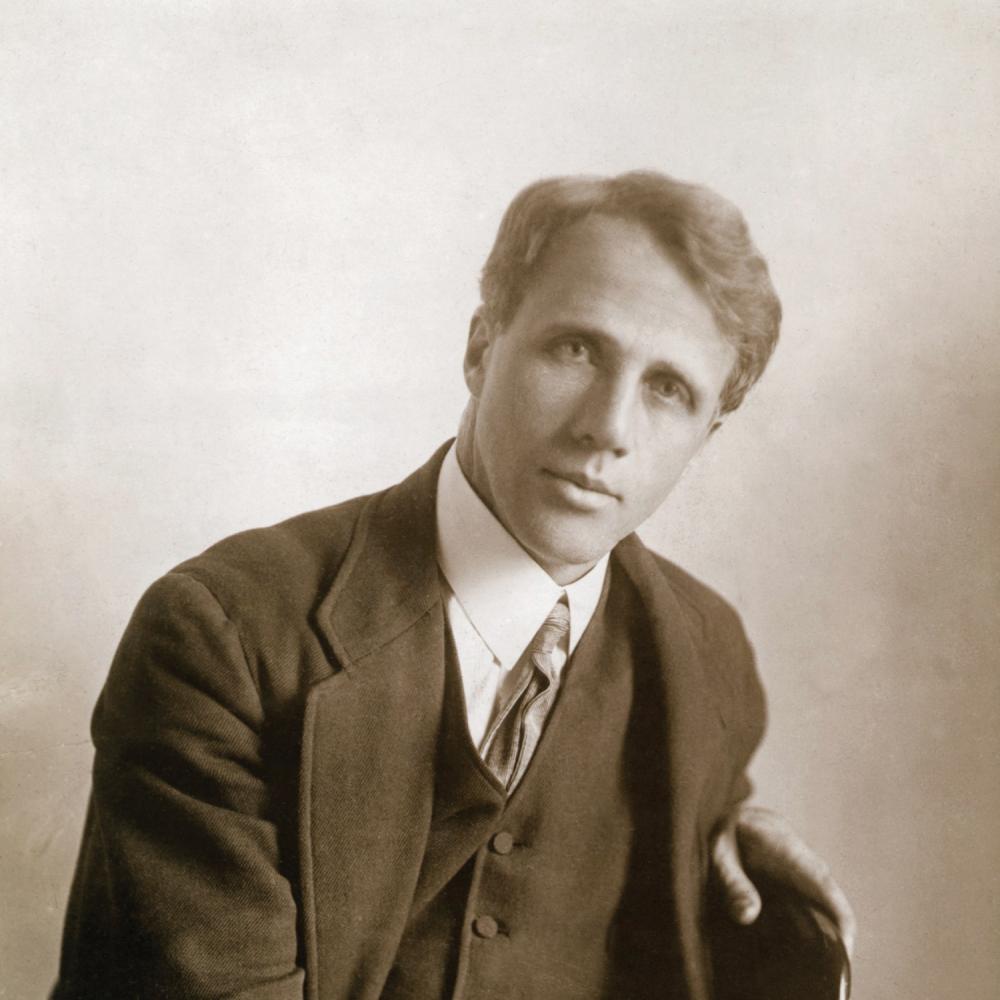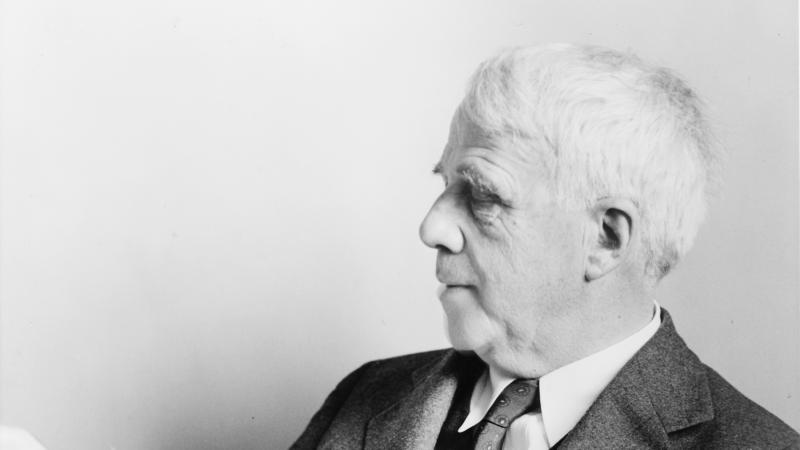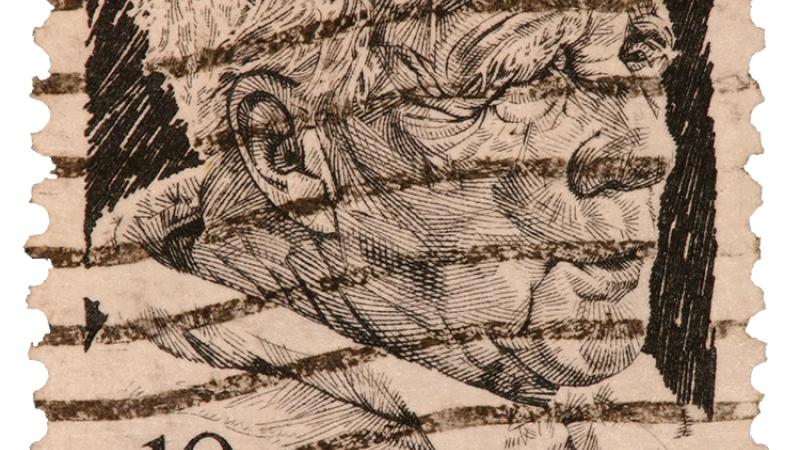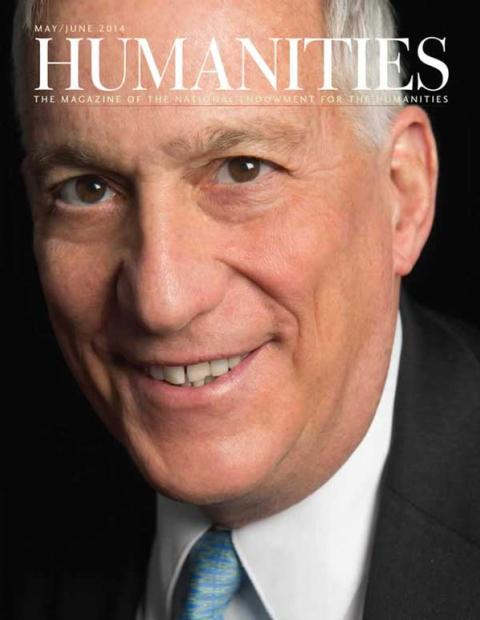By the time Robert Frost died in 1963 at the age of eighty-eight, he was not only a poet but a public institution, his presence as familiar to his fellow Americans as the Grand Canyon or the Washington Monument. In 1950, the U.S. Senate sent a birthday greeting to Frost, essentially wrapping his poetry in the national flag. “These poems have helped to guide American thought with humor and wisdom setting forth to our minds a reliable representation of ourselves and all men,” senators declared in their official resolution.
The Senate’s tribute was like coming out for motherhood and apple pie, a natural recognition of Frost’s stature in the popular culture. In the course of an eventful life, Frost won four Pulitzer Prizes and took an official post that was the period equivalent of the nation’s poet laureate. During World War II, the U.S. government printed an edition of Frost’s poetry for military personnel fighting abroad. In 1961, in one of the most iconic episodes in American letters, Frost offered a poem at President John F. Kennedy’s inaugural ceremony, reciting from memory “The Gift Outright,” a Frost standard, the harsh sunlight preventing him from reading a new poem he had written for the occasion. A year and a half later, at a critical period in the Cold War, Frost traveled to the Soviet Union as a cultural ambassador, winning an audience with Nikita Khrushchev and arguing for warmer relations between the rival superpowers. After Frost passed away, Kennedy spoke at the dedication of a library established in Frost’s name—perhaps the only time in which a sitting president so honored a man of letters. “Robert Frost was one of the granite figures of our time in America,” said Kennedy, who would be cut down by an assassin only weeks later. “He was supremely two things—an artist and an American.”
Frost seemed like the quintessential American, a reputation grounded in poems that read like plain talk spoken from the heart. The lack of apparent artifice in his poetry sounds appealingly democratic, his words arriving not from a temple or a mountaintop, but from a country meadow or backyard fence.
But poet Mary Oliver, speaking for many contemporary admirers of Frost, warns readers not to be fooled by his seeming simplicity. “Frost, it is believed by thousands who love his work, is easily understandable; he is clear, musical and bittersweet; in poem after poem he is felt to be rejoicing, if in a rather sad way, over the affairs of the world, especially the natural world,” Oliver writes. “I do not find that he rejoices at all.”
The trick here, as Oliver sees it, is that Frost’s poems are so wonderfully musical that they sound calm and assuring, although the text itself is often full of unresolved heartache and distress. While Oliver doesn’t make this analogy, her description of Frost’s poems prompts us to think of blues music, where sly and charming rhythms inspire a smile even as they carry news of sadness and dread. Here’s how Oliver puts it: “In fact we are hearing two different messages: everything is all right, say the meter and the rhyme; everything is not all right, say the words.”
Read just about any Frost poem, and you quickly realize what Oliver is talking about. An obvious example is one of Frost’s most famous compositions, “Stopping by Woods on a Snowy Evening.” The opening stanza, committed to memory by generations of schoolchildren, is a fair enough introduction to Frost’s technique:
Whose woods these are I think I know.
His house is in the village though;
He will not see me stopping here
To watch his woods fill up with snow.
Among the poem’s many gifts is its sublime sense of rhythm, which quietly simulates the trot of the traveler’s horse as he navigates a snowy road. The poem’s use of direct address is a nice touch. Immediately, we’re implicated as a confidant of the narrator, brought within his circle of intimacy. The telling of the story enfolds us as cozily as a lap robe as we, too, watch those woods fill up with snow.
The narrator allows himself a small respite, but then he nudges himself to move on, concluding with one of the most celebrated passages in American literature:
The woods are lovely, dark and deep,
But I have promises to keep,
And miles to go before I sleep,
And miles to go before I sleep.
Frost left “Stopping by Woods on a Snowy Evening” open to interpretation, and many readers have taken it as a contemplation of death. Much of the poem’s power rests on the notion of the woods as “lovely, dark and deep.” Frost seems to say, in witnessing both the beauty and the darkness, that they work in tandem—that human experience is a complex mix of the transcendent and the tragic.
Frost’s own life was touched by that bittersweet complexity. He was, despite his public posture of candor and charm, a hard man to figure out, his biography a knot of contradictions. “Robert Frost’s life began with a paradox,” critic Louis Untermeyer noted. “A stubborn Easterner, the most penetrating interpreter of New England, Frost was born in the Far West, in San Francisco, California.”
Born on March 26, 1874, to a newspaperman father and a schoolteacher mother, Frost was named after Confederate general Robert E. Lee, a nod to his father’s political sympathies. Frost’s father, who was a heavy drinker and emotionally volatile, died of tuberculosis in 1885, leaving the family with eight dollars in savings after burying him. Destitute, the Frosts relocated to Massachusetts to live with Frost’s paternal grandparents.
“That he came to appreciate, and to see in the imaginative way a poet must see, the imagery of Vermont and New Hampshire has something to do with the anomaly of coming late to it,” biographer Jay Parini observed. On this point, Parini quotes Robert Penn Warren: “A native takes, or may take, a place for granted; if you have to earn your citizenship, your locality, it requires a special focus.”
The perspective of an outsider—a condition common to writers—is an abiding vision in Frost’s poems. Much of his poetry places the narrator at a border of some sort, considering whether he can cross it. “Stopping by Woods on a Snowy Evening” is like that—a person standing at the edge of a forest, on a threshold between the demands of civilization and the call of the wild.
Maybe the most obvious example of Frost’s fascination with boundaries is “Mending Wall,” which begins with the telling observation, “Something there is that doesn’t love a wall, . . .” The opening of the poem isn’t remembered nearly as much as its closing words, “‘Good fences make good neighbors.’” That proverb endures in popular memory, misread as Frost’s endorsement of fence building. But, read as a whole, the poem suggests the opposite. Two neighbors are mending a stone wall after the ravages of winter. The narrator sees nature acting to dissolve the divisions thrown up by men, while the neighbor embraces fences from dumb habit.
“My long two-pointed ladder’s sticking through a tree / Toward heaven still,” says the narrator of “After Apple-Picking,” another Frost classic. “And there’s a barrel that I didn’t fill / Beside it, and there may be two or three / Apples I didn’t pick upon some bough.” Here, Frost considers the cosmic dividing line between heaven and earth—temporal labors pointing, like a poem itself, from the mortal to the divine.
To read these poems is to be reminded that Frost remained an outsider, even after he moved to New England. Throughout his life, he struggled to fit in. His education was irregular, routinely disrupted when Frost dropped out after suffering attacks of anxiety and depression that expressed themselves in various physical ailments. He attended Dartmouth and Harvard but graduated from neither, although his stint in high school had brought him perhaps the most important connection of his life. He fell in love with his co-valedictorian, Elinor Miriam White, and they eventually married, sharing six children and a mutual interest in the life of the mind.
Frost undertook a number of jobs over the years to support himself and his family, but his most important work beyond poetry was teaching, which, in the early years, primarily involved high school-age students. He was an energetic educator, and his proposed curriculum for Pinkerton Academy in Derry, New Hampshire, shows Frost’s ambition. The four-year course of study outlined by Frost included deep readings of everything from Treasure Island to Tennyson’s poems, complemented by extended exercises in writing. “The general aim of the course in English,” Frost declared, “is twofold: to bring our students under the influence of the great books, and to teach them the satisfaction of superior speech.”
Ultimately, Frost’s classroom experience, which eventually included periods teaching at several universities, shaped his approach to poetry. “I got something out of being a teacher,” Frost said. “I had to make things understood, and that put me in the class of poets that wanted to be understood.”
But Frost also conceded that his poems couldn’t simply be read on a surface level. “These poems are written in parable,” he said, “so the wrong people won’t understand them, and so be saved.”
By 1912, though, Frost had decided to leave teaching, at least temporarily, to devote more time to his poetry. The Frosts moved to England to live more cheaply and to indulge Elinor’s wish to “live under thatch.” Frost also enjoyed the prospect of living closely with the tradition of English lyric poetry. He counted Keats, Tennyson, and Chaucer among his favorites—a striking homage to precedent at a time when poets such as T. S. Eliot and Ezra Pound were embracing experiment. But Frost wasn’t naturally inclined toward the modernist school, and his affection for old forms proved comforting to readers on both sides of the Atlantic. He cautioned against constantly searching for “new ways to be new,” arguing that poets should instead “play with words as we find them.”
Frost’s English period secured his success as a writer, presenting yet another paradox: an iconic American poet who didn’t really catch on until he landed in Great Britain. His poems quickly found a publisher in England, and, with critical support from Pound and others, he was on his way. Frost returned to America with a dramatically heightened profile in 1915. The publication of A Boy’s Will and North of Boston advanced his fame, and his resettlement in New England established him firmly as a tribune of the regional landscape.
In making New England his primary home, Frost also affirmed his allegiance to an earlier New Englander, Ralph Waldo Emerson. Frost was especially drawn to Emerson’s belief that language should embrace the physical world. “Some of my first thinking about my own language was certainly Emersonian,” said Frost. “‘Cut these sentences, and they bleed,’ he says. I am not submissive enough to want to be a follower, but he had me there. I never got over that.”
Before and after his English sojourn, Frost lived much of his life on New England farms, although he resisted suggestions that he was a nature poet. “I guess I’m not a nature poet,” said Frost. “I’ve only written two poems without a human being in them—only two.”
But Frost acknowledged that nature strongly informed his worldview. “Nature is always more or less cruel,” Frost said. “The woods are all killing each other anyway. That’s where the expression comes from, ‘a place in the sun’—a tree wanting a place in the sun that it can’t get. The other trees won’t give it to it.”
Such dark themes color many—if not most—of Frost’s poems. In “Home Burial,” a husband and wife confront a wall every bit as formidable as the barrier in “Mending Wall,” but this dividing line is an emotional one brought about by the death of a child. “The Death of the Hired Man,” as the title suggests, addresses equally somber realities.
The tragic implications of Frost’s poems don’t square neatly with his benign image as the good, grand uncle of American letters. He was a late bloomer, not publishing his first book until he was nearly forty, and the public didn’t widely know Frost until he had ripened into maturity—a white-haired figure with a quaint New England accent who sounded wise and a little cranky but rather harmless.
Behind the avuncular image was a more complicated man defined by an equally complicated history. Four of Frost’s six children died before he did, including Carol, the son who committed suicide. Frost’s daughter Irma suffered mental problems that required hospitalization, and Elinor battled anxiety, too. She died of heart failure in 1938. Frost’s own bouts of depression brought physical and mental anguish. “Cast your eye back over my family luck, and perhaps you will wonder if I haven’t had pretty near enough,” he lamented at one point.
Given his domestic troubles and his inner demons, what was Frost like to be around? That question has stirred lively debate among his biographers for decades. Beyond dispute is the evidence of Frost’s temper, which occasionally expressed itself physically. He once instigated a fight with one of his mother’s boarders, and he threatened to come to blows with an English gamekeeper. Early biographers of Frost presented a sanitized version of the poet, but Lawrance Thompson’s exhaustive account of Frost’s life depicted him as something of a monster, self-absorbed and vindictive.
Jay Parini’s Robert Frost: A Life questions some of Thompson’s research methods and presents a more balanced appraisal of Frost’s character. “The view of Frost as a monster and a misanthrope that has been lodged in the minds of readers by previous biographers is hugely distorted,” Parini writes. “While hardly a saint, Frost was a passionate, headstrong man who believed deeply in his own vision. Like any human being, he was not without jealousy; indeed, he could be irritable and difficult, even mean-spirited, when it came to his poetic rivals. But to a remarkable degree, he succeeded in making a place for himself in the world of letters.”
Parini also stresses that Frost defies easy summary because he was a man of paradox: “The contradictions of his life . . . remain stunning. He was a loner who liked company; a poet of isolation who sought a mass audience; a rebel who sought to fit in. Although a family man to the core, he frequently felt alienated from his wife and children and withdrew into reveries. While preferring to stay at home, he traveled more than any poet of his generation to give lectures and readings, even though he remained terrified of public speaking to the end.”
The continuing debate about Frost’s personality resurfaced last February on the front page of the New York Times, which noted the arrival of a new volume of Frost’s letters, along with abiding questions about the poet’s real nature. Donald Sheehy, who edited the letters along with fellow scholars Mark Richardson and Robert Faggen, pointed to the letters as evidence of Frost’s deep humanity—a corrective to Thompson’s harsher view of the literary legend. “These letters will dispel all that,” Sheehy told the Times. “Frost has his moods, his enemies, the things that set him off. But mostly what you see is a generosity of spirit.”
The new collected correspondence, The Letters of Robert Frost: 1886–1920, is published by Harvard University Press, which plans to produce three more volumes of Frost’s letters.
In their preface, the editors of the new Frost letters note that the volume deliberately offers no “interpretive or evaluative framework” for the poet. Readers are free to read Frost’s mail and draw their own conclusions about him. But the evidence here is somewhat limited by the lack of personal letters to family members in volume I. Most of the correspondence deals with business matters. Even so, one gets flashes of Frost’s inner life. In an April 22, 1894, note to literary editor Susan Hayes Howard, for example, Frost reveals an unalloyed audacity: “Such an one am I that even in my failures I find all the promise I require to justify the astonishing magnitude of my ambition.”
To read the letters is to be reminded that he was a true original. Frost has few obvious descendants in American letters, and his singularity perhaps accounts for the fact that a half a century after his death, he’s still widely read. His closest heir is probably Mary Oliver, who also uses the natural world as a lens to view emotionally complex topics.
Oliver doubts that anyone will ever fully know who Frost was. “But we would spend our time more profitably in the texts of his poems than in the chapters of his life,” she concludes. “We do not have the man, or at least we do not know for sure if we have him—we have his work.”




